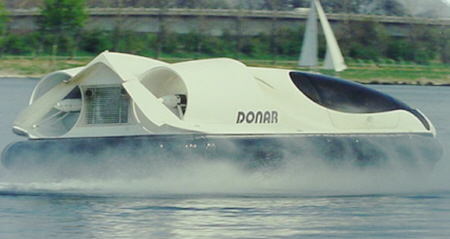 Ailerons:
Ailerons:
The two ailerons, one at the outer trailing edge of each wing, are
movable surfaces that control movement about the longitudinal axis. The
movement is roll. Lowering the aileron on one wing raises the aileron
on the other. The wing with the lowered aileron goes up because of its
increased lift, and the wing with the raised aileron goes down because
of its decreased lift. Thus, the effect of moving either aileron is
aided by the simultaneous and opposite movement of the aileron on the
other
wing.
Rods or cables connect the ailerons to each other and to
the control wheel (or stick) in the cockpit. When pressure is applied
to the right on the control wheel, the left aileron goes down and the
right aileron goes up, rolling the airplane to the right. This happens
because the down movement of the left aileron increases the wing camber
(curvature) and thus increases the angle of attack. The right aileron
moves upward and decreases the camber, resulting in a decreased angle
of attack. Thus, decreased lift on the right wing and increased lift on
the left wing cause a roll and bank to the right.
Which gives you the idea on a aircraft which has free
airflow over the wings and a free movement of roll - in a Hovercraft we
do not have wings , nor a free airflow over a big surface like a wing.
If we want to accomplish a similar roll and bank action on a
Hovercraft ...we would need to apply this control surface at the
thrust duct exit or behind the thrust propeller - the only place where
we have sufficient airflow over the control surface. But we dod
not need the high angle of a aircraft ...only a 1 or 2 degree roll /
bank moition would be sufficient for a Hovercraft . The most common way
is with a control surface which is in a 45 degree angle from the center
out.

A roll and bank control surface would be very helpful if
you go in a
turn and could lean the craft into the turn before initiating the
actual turn to increase the air-gap on the outer skirt section while
decreasing on the inner skirt creating friction against the surface.
An other approach or solution is by skirt shifting to create same
motion to the hull without the need of a control surface.
Elevators:
The elevators control the movement of the airplane about
its lateral axis. This motion is pitch. The elevators form the rear
part of the horizontal tail assembly and are free to swing up and down.
They are hinged to a fixed surface--the horizontal stabilizer.
Together, the horizontal stabilizer and the elevators form a single
airfoil. A change in position of the elevators modifies the camber of
the airfoil, which increases or decreases lift.
Like the ailerons, the elevators are connected to the
control wheel (or stick) by control cables. When forward pressure is
applied on the wheel, the elevators move downward. This increases the
lift produced by the horizontal tail surfaces. The increased lift
forces the tail upward, causing the nose to drop. Conversely, when back
pressure is applied on the wheel, the elevators move upward, decreasing
the lift produced by the horizontal tail surfaces, or maybe even
producing a downward
force. The tail is forced downward and the nose up.
The elevators control the angle of attack of the wings.
When back pressure is applied on the control wheel, the tail lowers and
the nose raises, increasing the angle of attack. Conversely, when
forward pressure is applied, the tail raises and the nose lowers,
decreasing the angle of attack.
To shift a Hovercraft on its lateral axis is important
to get a Hovercraft over hump ( especially on water ) to overcome its
own wake and stabilize the craft during acceleration. On a hard surface
the craft would be slightly tilted aft ( approximately 2 - 3 degree).
On a wet start ( starting the Hovercraft on water and accelerating from
a dead stand still to overcome its own wake ) the craft will blow a
"hole in the water " or in other words it will displace the water under
the craft with air.
When the craft will accelerate it creates a wave in front of the skirt.
Now you need to push the wave and climb over it. During this phase its
helpful to be able to change the Hovercraft on its lateral axis via
control surfaces.
Once you overcome your own wake ( around 12 - 15 miles speed ) you
leave your wake behind you as well do not blow a hole in the water
anymore.
Elevators are normally attached to the thrust duct exit or behind the
propeller in a horizontal axis / sometimes slightly tilted to combine
elevator and aileron in one control surface.
Rudder:
The rudder controls movement of the airplane about its
vertical axis. This motion is yaw. Like the other primary control
surfaces, the rudder is a movable surface hinged to a fixed surface
which, in this case, is the vertical stabilizer, or fin. Its action is
very much like that of the elevators, except that it swings in a
different plane--from side to side instead of up and down. Control
cables connect the rudder to the rudder pedals.
In a Hovercraft the rudder has to be behind the thrust exit - either
duct or prop. In some applications short rudders are used to allow
forward trust while creating sideways thrust to reduce craft tilt.

Reverse thrust
buckets :
Are a common
feature on Neoteric Hovercraft which use
them for steering ( rudder ) and reverse thrust - the following clip
should help you understand the principle which is to turn the airflow
around.
|

